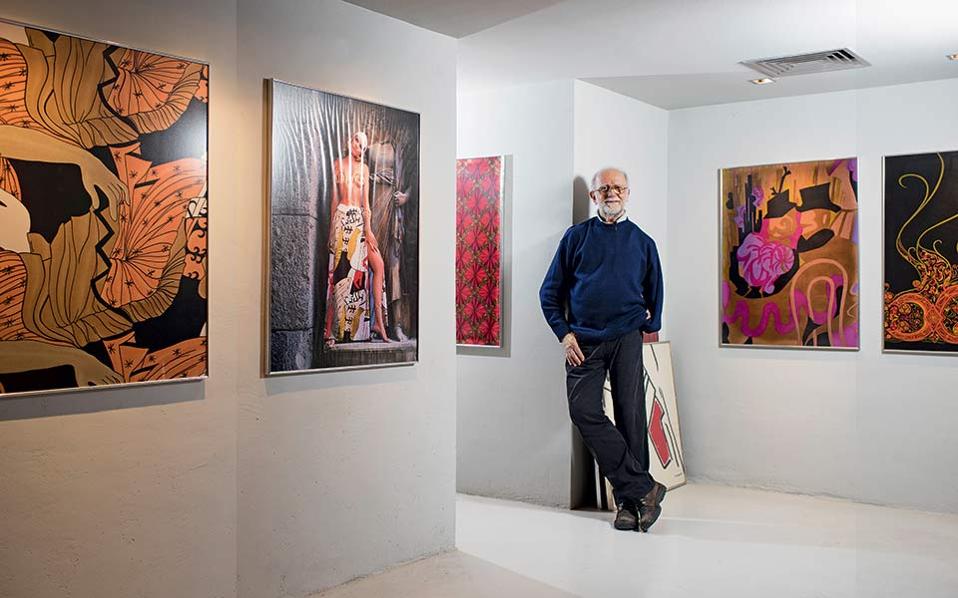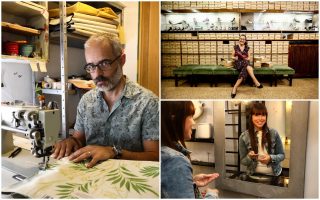Yannis Tseklenis, titan of Greek fashion, passes

Yannis Tseklenis, a titan of Greek fashion and a key figure in shaping and promoting the concept of “Greek chic” on the international stage died on Wednesday at the age of 82.
Born in Athens in 1937, Tseklenis came to be considered the premier Greek fashion designer of the second half of the 20th century. From 1965 to 1991 his creations were sold at top boutiques and shops in over 30 countries around the world, an unprecedented achievement at the time for a designer from Greece. At a time when the country was seeking to embrace a new era of optimism and modernity, Tseklenis was instrumental in defining and popularizing the Greek aesthetic, with a wide-ranging influence that remains evident to this day.
At once unmistakably Hellenic – drawing on wide-ranging themes from the country’s long history – yet also bold, colorful and forward-looking, Tseklenis’ textiles and designs garnered him great international acclaim, with outlets such as the New York Times and Life magazine lauding the designer. Films of his collections are now kept in the archives of the Metropolitan Museum of Art in New York.
His talent, skill and creativity also caught the eye of royalty, and he was chosen to shape the interior decoration and design for the celebrations of the wedding of Princess Sofia and Prince Juan Carlos of Spain in 1962, and, two years later, that of Queen Anne-Marie and King Constantine II of Greece.
A true polymath in the sphere of art and design, Tseklenis created everything from uniforms for flight attendants and students to furniture fabrics. The company he headed in Greece grew to become a significant contributor to the national economy.
In 1977 he was diagnosed with a malignant form of melanoma which threatened his life and led to the amputation of his left arm. Yet, after recovering, he went on to dominate the world of Greek fashion and textiles for another 12 years.
In the 1990s, driven in part by the forces of deindustrialization, Tseklenis moved away from fashion and textile production. He turned primarily to interior design, working on everything from sophisticated hotels and holiday homes to train interiors.
In 1997 he donated almost all his prototype garments from his 1970s and 1980s fashion collections to the Peloponnesian Folklore Foundation, for which he had great affection.
He remained active until the very end of his life, revisiting in recent years his original designs from his thematic textile collections and creating a new line of pure silk scarves made in Greece, providing an important boost to the traditional silk industry of Soufli in northern Greece. He was also preparing a large retrospective exhibition of his work scheduled for the end of the year; organizers say this will go ahead in his honor.
Tseklenis remained positive about Greece and it’s creative potential, drawing parallels between the country of today and that of the mid 1970s when Greece emerged from under military rule to embrace a new, hopeful period.
Below are excerpts from an interview he gave in 2017 to Sandy Tsantaki about his life’s work, and his thoughts on Greece and the future:
“Watching the sunset from my house on Santorini is what I love the most. Not during the summer, though. Always in spring or autumn, when the island isn’t full of tourists and I’m able to enjoy the enchantment of the caldera in absolute tranquility.
“I feel particularly nostalgic about the 1975-76 period in Greece. Not for the time just before that (when we were ruled by a military dictatorship) or a bit after that (when I had my encounter with cancer), but those two years were a period of hope, a time when we felt we would achieve greatness, that magnificent things would happen in our country. And today, we happen to be emerging from a huge crisis once again; we are beginning to feel hope, to see light – or at least the most optimistic among us are. History is repeating itself, some 40 years later.
“I’ve been observing with real joy – though I am now fully involved in hotels and residential projects – what has been going on in fashion recently. I see that my thematic approach to textile and clothing collections has become timely again, although it’s being interpreted a little differently by today’s young, talented designers. In fact, I’m not done with these concepts yet, either. Betting on the nostalgia of the women whom I had dressed back then, I recently found myself back in Soufli [a town on the northeastern border of Greece, with a long tradition in silk production], repeating themes from my beloved scarf collections.
“A standout collection for me, and the timeliest, is my 1999 ‘Retrospective,’ in which I had used mixed themes from my previous work. I’ve donated it in full, all 100 pieces, to the Peloponnesian Folklore Foundation in Nafplio, along with another 800 originals. Whenever I see it in photographs, I feel that, were it to go into a shop tomorrow, it would sell out entirely.
“I believe that these days there’s more talent expressing itself in Greece than ever before, and I hope that everyone continues working with tenacity, and overcoming the difficulties stemming from the lack of production infrastructure. The challenge is still the same, especially for young people: to be outward-looking in their business. As long as it’s worth the effort, that is; if the country benefits from the added value. Produce in low-cost countries, yes, but export from Greece. And, as the country today has a great reputation in the field of tourism, it would be a very good idea to emphasize summer and resort fashion collections all year long. Of course, the clothing must echo the seasons in Greece.
“Looking back on all those Greeks who made us proud wherever we were in the world, I think about composers like Mikis Theodorakis and Manos Hatzidakis, about the director Costa-Gavras, the poets Seferis and Elytis, of doctors like George Cotzias (who discovered the treatment for Parkinson’s disease) and George Papanicolaou (who developed the Pap Smear), and of Aristotle Onassis and Stavros Niarchos, of Melina Mercouri and Irene Papas. I used to “steal” from their glamour back then, whenever I, too, as a name, came up in references made to Greece.
“I’m proud of the international successes of Greeks today, too, like Yorgos Lanthimos in the cinema. I’m delighted that Sophia Kokosalaki and Mary Katrantzou are distinguishing themselves in the fashion world. And I’m proud of all the Greek researchers in the health sector, who are so active everywhere. In ten years, Greeks will dominate the world of research.
“I love Metaxourgeio as a neighborhood, and not only because I have invested in it. Most people today get to know it through social events that take place there, or thanks to certain good restaurants, such as Funky Gourmet with its two Michelin stars. Had Metaxourgeio been spared the last 20 years of decay, it would be one of the nicest places in Europe today. It represents the old, humble Athens. If all the abandoned houses were renovated, if their faÇades were repaired and painted, this would be the perfect place for a walk. If you do wander around the area, I recommend making a stop at the very beautiful neoclassical building at 13 Germanikou Street, which I have restored, with much affection.
“If you asked me my favorite destinations in Greece, I’d have to say Mani, Tinos, Santorini (in spring and fall, as I said before). Koufonisia, too, because they are unspoiled and tranquil islands that retain something of the past.
“Every traveler to Athens should visit the National Archaeological Museum on Patission Street. It is, in my opinion, more important than the Acropolis Museum for a number of reasons.
“The city needs a facelift, especially in its central districts.The exteriors of the apartment blocks have to be beautified and the neoclassical buildings restored, in order for Athens to become more attractive. If I were to become a minister, my first priorities would be cleanliness and order, and the restoration of the facades of the buildings.”
This article first appeared in Greece-Is.com, an English-language publishing initiative by Kathimerini.






